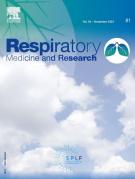Management of non-small cell lung cancer after 2 years of immunotherapy Experience of a French center - 26/03/25
 , Jacques Cadranel a, Constance Méteyé a, Samy Houari b, Lise Rosencher a, Christelle Epaud a, Jérémy Slomka a, Vincent Fallet a, Anthony Canellas a
, Jacques Cadranel a, Constance Méteyé a, Samy Houari b, Lise Rosencher a, Christelle Epaud a, Jérémy Slomka a, Vincent Fallet a, Anthony Canellas aCet article a été publié dans un numéro de la revue, cliquez ici pour y accéder
Abstract |
Background |
The optimal management strategy for metastatic or advanced-stage non-small-cell lung cancer (NSCLC) after 2 years of immune checkpoint inhibitor (ICI) remains unclear.
Methods |
We conducted a single-center retrospective observational study to characterize the management of patients who received at least 2 years of ICI in the first-line setting for a metastatic or advanced-stage NSCLC.
Results |
Among the 254 patients that received ICI in the first-line setting, 39 (15%) achieved 2 years of treatment (ICI in monotherapy, n=14; ICI with chemotherapy, n=25). ICI was discontinued after 2 years (<30 months) in 31 (79%) of the cases. During the first 2 years, 29 patients (74%) had no disease progression (2 complete radiological responses, 25 partial radiological responses, and 2 stable diseases) and 10 patients (26%) experienced at least one oligo-progression, which was treated with local ablative treatment (LAT), allowing continuation of ICI up to 2 years. A positron emission tomography (PET) scan was performed at 2 years for 37 patients (95%), revealing a complete metabolic response (CMR) in 16 individuals (43%). None of these patients progressed subsequently (median follow-up: 13 months). After 2 years of ICI, the 12-month progression-free survival was 100% in case of CMR versus 49% (95% CI, 29-91) in the absence of CMR (p=0.00037).
Conclusions |
A CMR at 2 years of ICI is associated with a favorable prognosis. Further studies are needed to better establish the role of PET scan at 2 years, the relevance of LAT and the optimal duration of ICI.
Le texte complet de cet article est disponible en PDF.Keywords : Duration of Therapy, Immune checkpoint inhibitors, Immunotherapy, Lung neoplasms, Non-Small-Cell Lung Carcinoma
Abbreviations : ALK, bMRI, CI, CMR, CR, CT, ECOG PS, EGFR, HR, ICI, LAT, L1, L+, NR, NSCLC, OR, ORR, OS, PFS, PET, PR, SD, TFS
Plan
Bienvenue sur EM-consulte, la référence des professionnels de santé.
L’accès au texte intégral de cet article nécessite un abonnement.
Déjà abonné à cette revue ?

